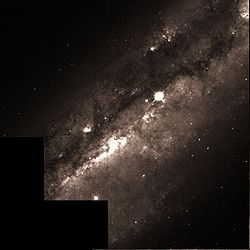- Messier 108
-
Messier 108 
A Hubble Space Telescope image of M108.Observation data (J2000 epoch) Constellation Ursa Major[1] Right ascension 11h 11m 31.0s[2] Declination +55° 40′ 27″[2] Redshift 699 ± 9 km/s[2] Distance 14.1 Mpc[3] Type SB(s)cd[4] Apparent dimensions (V) 8′.7 × 2′.2[2] Apparent magnitude (V) 10.7[2] Other designations NGC 3556,[2] PGC 34030,[2] UGC 6225[2] See also: Galaxy, List of galaxies Messier 108 (also known as NGC 3556) is a barred spiral galaxy in the constellation Ursa Major. It was discovered by Pierre Méchain in 1781 or 1782.[5] From the perspective of the Earth, this galaxy is seen almost edge-on.
This galaxy is an isolated[3] member of the Ursa Major Cluster cluster of galaxies in the Virgo supercluster. It has a morphological classification of type SBbc in the de Vaucouleurs system, which means it is a barred spiral galaxy with somewhat loosely wound arms. The maximum angular size of the galaxy in the optical band is 11′.1 × 4′.6, and it is inclined 75° to the line of sight.[4]
This galaxy has an estimated mass of 125 billion times the mass of the Sun and includes about 290 ± 80 globular clusters.[6] Examination of the distribution of neutral hydrogen in this galaxy shows shells of expanding gas extending for several kiloparsecs, known as H1 supershells. These may be driven by bursts of star formation activity, resulting in supernovae explosions. Alternatively they may result from an infall of gas from outside the galaxy or by radio jets.[7]
Observations with the Chandra X-ray Observatory have identified 83 X-ray sources, including a source located at the nucleus. The brightest of these sources may be an intermediate-mass black hole that is accreting matter. The galaxy is also emitting a diffuse soft X-ray radiation within 10 kpc of the optical galaxy.[3] The spectrum of the X-ray source at the core is consistent with an active galactic nucleus, but an examination with the Spitzer Space Telescope shows no indication of activity. The supermassive black hole at the core has an estimated mass equal to 24 million times the mass of the Sun.[8]
See also
- NGC 2403 - a similar spiral galaxy
- NGC 4631 - a similar spiral galaxy
- NGC 7793 - a similar spiral galaxy
References
- ^ R. W. Sinnott, ed (1988). The Complete New General Catalogue and Index Catalogue of Nebulae and Star Clusters by J. L. E. Dreyer. Sky Publishing Corporation/Cambridge University Press. ISBN 0-933-34651-4.
- ^ a b c d e f g h "NASA/IPAC Extragalactic Database". Results for NGC 3556. http://nedwww.ipac.caltech.edu/. Retrieved 2007-06-21.
- ^ a b c Wang, Q. Daniel; et al. (2003). "Chandra Observation of the Edge-on Galaxy NGC 3556 (M 108): Violent Galactic Disk-halo Interaction Revealed". arXiv:astro-ph/0308150 [astrop-ph].
- ^ a b Tully, R. B.; Fisher, J. R. (1977). "A new method of determining distances to galaxies". Astronomy and Astrophysics 54 (3): 661–673. Bibcode 1977A&A....54..661T.
- ^ Kepple, George Robert; Glen W. Sanner (1998). The Night Sky Observer's Guide. Vol. 2. Willmann-Bell. p. 399. ISBN 0-943396-60-3.
- ^ Rhode, Katherine L.; et al. (2007). "Global Properties of the Globular Cluster Systems of Four Spiral Galaxies". Astronomical Journal 134: 1403–1418. Bibcode 2007AJ....134.1403R. doi:10.1086/521397.
- ^ Gopal-Krishna; Irwin, Judith A. (2000). "Radio jet-blown neutral hydrogen supershells in spiral galaxies?". Astronomy and Astrophysics 361: 888–894. arXiv:astro-ph/0008251. Bibcode 2000A&A...361..888G.
- ^ Satyapal, S.; et al. (2008). "Spitzer Uncovers Active Galactic Nuclei Missed by Optical Surveys in Seven Late-Type Galaxies". Astrophysical Journal 677 (2): 926–942. Bibcode 2008ApJ...677..926S. doi:10.1086/529014.
External links
- SEDS: Spiral Galaxy M108
- Messier 108 on WikiSky: DSS2, SDSS, GALEX, IRAS, Hydrogen α, X-Ray, Astrophoto, Sky Map, Articles and images
Coordinates:
 11h 11m 31.0s, +55° 40′ 27″
11h 11m 31.0s, +55° 40′ 27″Messier objects List M1 · M2 · M3 · M4 · M5 · M6 · M7 · M8 · M9 · M10 · M11 · M12 · M13 · M14 · M15 · M16 · M17 · M18 · M19 · M20 · M21 · M22 · M23 · M24 · M25 · M26 · M27 · M28 · M29 · M30 · M31 · M32 · M33 · M34 · M35 · M36 · M37 · M38 · M39 · M40 · M41 · M42 · M43 · M44 · M45 · M46 · M47 · M48 · M49 · M50 · M51 · M52 · M53 · M54 · M55 · M56 · M57 · M58 · M59 · M60 · M61 · M62 · M63 · M64 · M65 · M66 · M67 · M68 · M69 · M70 · M71 · M72 · M73 · M74 · M75 · M76 · M77 · M78 · M79 · M80 · M81 · M82 · M83 · M84 · M85 · M86 · M87 · M88 · M89 · M90 · M91 · M92 · M93 · M94 · M95 · M96 · M97 · M98 · M99 · M100 · M101 · M102 · M103 · M104 · M105 · M106 · M107 · M108 · M109 · M110See also  Book:Messier objects ·
Book:Messier objects ·  Category:Messier objects
Category:Messier objects  Portal:AstronomyCategories:
Portal:AstronomyCategories:- Spiral galaxies
- Barred spiral galaxies
- Ursa Major constellation
- Messier objects
- NGC objects
- UGC objects
- PGC objects
Wikimedia Foundation. 2010.

